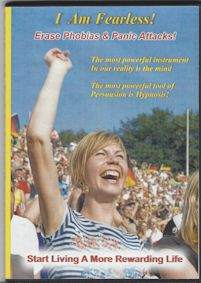Claustrophobia and Hypnotherapy
By Alan B. Densky, CH
Claustrophobia is a fear of enclosed or confined spaces. It is an extremely common phobia that affects men and women of all ages. It affects people in a variety of different situations, and when triggered, it can make a person feel scared and humiliated. To overcome this phobia, hypnotherapy techniques provide amazing results to people who are sick and tired of being held back by their fears.
People with claustrophobia experience fears associated with small spaces or areas where it may be difficult to exit quickly, such as elevators, trains or airplanes. Some people even feel claustrophobic in MRI scanning machines. Due to their fear, claustrophobia sufferers tend to avoid closed-off spaces. Sufferers also tend to sit close to exits or along the sides of a room, versus approaching the center. Claustrophobic people frequently experience anxiety attacks when they begin to feel "trapped" or closed in. For some people, being in a tight space is as terrifying as being buried alive.
Having
a panic attack in a confining space can be a frightening experience for
claustrophobic people and those around them. When an individual's claustrophobia
is triggered, they will often experience anxiety attacks, difficulty breathing,
nausea, fainting, and other, often extreme, reactions. A person can develop
claustrophobia at any age or in response to a traumatic event, but its onset
often occurs during childhood.
Claustrophobia can be triggered by many different situations, which may vary
from person to person. For example, some claustrophobic people may only feel
nervous while riding an elevator, while other people find large crowds trigger
their condition. Regardless of the particular situation, claustrophobia and
other phobias tend to interfere with people's daily lives and personal
satisfaction. People with phobias often develop avoidant behaviors and suffer a
decreased quality of life as they plan out their activities around their fears.
For many sufferers, the fear of embarrassment or humiliation over their phobia
is as debilitating as the phobia itself. Many phobia sufferers recognize that
their fears are overblown and irrational, but cannot seem to keep themselves
from losing self-control. The reason for this is because phobias are rooted deep
within the unconscious mind, which no amount of conscious effort can be fully
effective in controlling. This poses a special challenge to the treatment of
phobias.
Claustrophobia can be treated with anti-anxiety medication or therapy. Hypnosis
is an excellent, safe and non-invasive form of treatment with no negative side
effects. It works by targeting the underlying causes of fear in the unconscious
mind to rapidly
eliminate a phobia. In particular, a program that utilizes Ericksonian
hypnotherapy techniques and Neuro-Linguistic Programming (NLP) can be used to
treat a phobia. This revolutionary program uses a variety of hypnosis techniques
to help people overcome their fears.
The first step in the treatment process is helping the phobia sufferer become
relaxed and anxiety-free. Hypnosis has long been used as a form of stress-relief
treatment, to help people clear their minds and focus deeply.
Traditional hypnosis techniques have made use of direct, post-hypnotic
suggestions to help treat phobias. The problem with the direct approach is that
the conscious mind tends to resist being merely "told" what to do. So
many people throw up barriers to acceptance of suggestions. In this day and age,
people are particularly prone to resist direct suggestions because we tend to be
independent thinkers who question everything.
The very essence of they hypnotic
state is deep relaxation. Once in the relaxed state, rather than using
post-hypnotic suggestions, an alternate approach known as systematic
desensitization can often help extinguish a phobia through visual imagery.
Ericksonian hypnotherapy uses a more refined approach that conventional
techniques. It uses indirect suggestions hidden in interesting metaphors and
stories to engage the unconscious mind and persuade it to follow a desirable,
phobia-free thought process. Since indirect suggestions do not need to be
specifically tailored to a single phobia like direct post-hypnotic suggestions
do, one good Ericksonian hypnosis program can work to successfully treat any
phobia or even multiple phobias.
NLP, Neuro-Linguistic Programming, is a modern form of treatment that many
highly trained consulting hypnotists have adopted. The most effective NLP
technique for eliminating a phobia is called the Visual - Kinesthetic
Disassociation, or V/K. The V/K is known as the one session phobia cure, and
with good reason. Phobic or panic reactions (attacks) take place because
traumatic feelings are attached to and triggered by mental images. With the V/K,
the traumatic feelings are disconnected from the mental images - often in just
one session, and the phobia is essentially extinguished.
People struggling with claustrophobia can find rapid relief by using
hypnotherapy. The combination of Ericksonian hypnosis and NLP techniques can
help anyone overcome their fears. Hypnotherapy has helped countless people feel
safe and comfortable in situations where earlier, they would have completely
broken down. The techniques of hypnosis have provided phenomenal benefits for
sufferers of phobias and continue to change lives each and every day.
© 2007By Alan B. Densky, CH. This document may NOT be re-printed without permission. All Rights Reserved. We are happy to syndicate our articles to approved websites.



